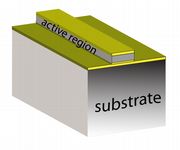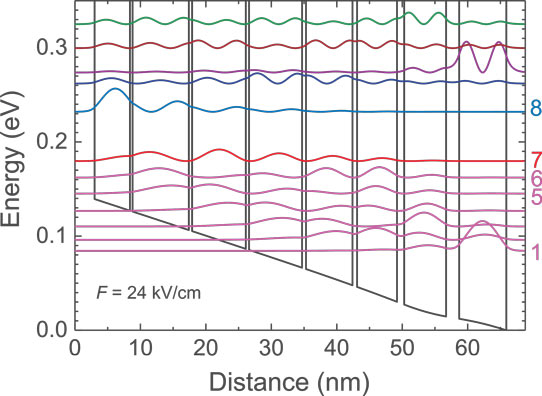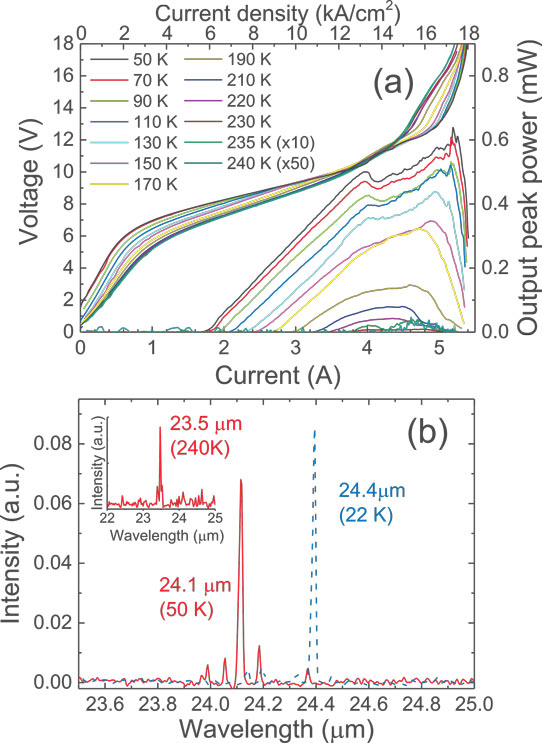- News
24 October 2014
Mid-infrared quantum cascade laser with 24.4μm wavelength
ETH Zurich has produced a quantum cascade laser (QCL) that is claimed to have the longest mid-infrared (MIR) wavelength so far [K. Ohtani et al, Appl. Phys. Lett., vol105, p121115, 2014].
 Figure 1: Double metal waveguide structure for QCL laser bar.
Figure 1: Double metal waveguide structure for QCL laser bar.
The device operated near the troublesome ‘reststrahlen’ band of the compound semiconductors used. Light within a reststrahlen band is unable to propagate because of strong coupling/resonance with lattice vibrations (phonons).
A double metal waveguide structure (Figure 1) was used to avoid reststrahlen arising from the usual indium phoshide substrate used to create MIR QCLs. The researchers also carefully optimized the dielectric constant of the QCL heterostructure using simulations.
The QCL structure (Figure 2) used a bound-to-continuum scheme. Diagonal transitions between states centered in different wells were used to increase the upper-state lifetime (0.4ps calculated). The lower-state lifetime was simulated at 0.26ps, allowing population inversion to be achieved.

Figure 2: Calculated conduction band diagram and relevant wave functions of one period of active/injection layers with applied electric field of 24kV/cm. Diagonal laser transition with dipole matrix element of 5.6nm occurs between states 7 and 8.
The researchers grew lattice-matched laser structures with In0.53Ga0.47As wells and In0.52Al0.48As barriers on lightly doped indium phosphide (InP) using solid-source molecular beam epitaxy. The laser diode structure included 40nm silicon-doped InGaAs bottom contact, 60 repeats of the InGaAs/InAlAs injection/active QCL structure, and a 40nm n-InGaAs top contact.
Ridge laser structures with double metal waveguide were produced. Thermocompression was used for gold-gold wafer bonding and transfer to a handling substrate. The InP growth substrate was removed using chemical mechanical polishing (CMP) and selective etching. The (originally) bottom InGaAs contact was etched away to reduce waveguide losses. The ridge width was 30μm. The material was cleaved into 0.5–3.0mm-long cavities.
A 1mm-long device with 24.1μm center wavelength had a threshold current density of 5.7kA/cm2 at 50K. The peak output power averaged 0.6mW. Laser operation was seen at up to 240K, a significant increase on the 140-170K previously achieved in the same wavelength range. The emission wavelength shifted from 24.1μm to 23.5μm between 50K and 240K, respectively, due to the Stark effect.

Figure 3: (a) Temperature dependence of light output–current–voltage characteristics. Current pulses of 100ns duration at frequency of 490Hz were used. (b) Laser emission spectra taken by a rapid-scan Fourier infrared spectrometer of resolution 0.125/cm. Inset shows spectrum at maximum operation temperature, 240K. Blue dotted line is spectrum at 22K for QCL having 3% thicker InGaAs wells.
The improvement in thermal performance was attributed to a high dynamic range of the current density of 2.2 ((18–5.7)/5.7), based on a maximum current density of 18kA/cm2 at 50K. The characteristic temperature, T0, for the threshold current was 217K.
Another device with 3% thicker InGaAs wells achieved a 24.4μm center wavelength at 22K – “the longest wavelength in MIR QCLs so far reported,” according to the researchers. A 24μm wavelength device was achieved in 2002.
Mid-infrared quantum cascade laser InP CMP
http://dx.doi.org/10.1063/1.4896542
The author Mike Cooke is a freelance technology journalist who has worked in the semiconductor and advanced technology sectors since 1997.


